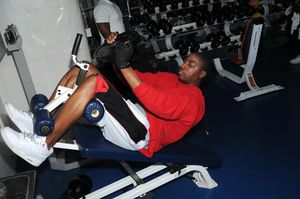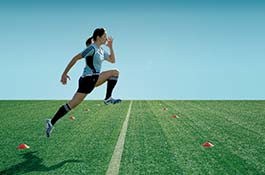Strength Training versus Power Training
Original Editor - Your name will be added here if you created the original content for this page.
Top Contributors - Lucinda hampton
Introduction[edit | edit source]
The main difference between Power Training vs Strength Training is, that strength refers to the ability to overcome resistance, while power refers to the ability to overcome resistance in the shortest period of time.
What is Strength?
The definition of strength is:
Strength is the ability to exert force (measured in Newtons) in order to overcome the resistance.
The formula for force says force is equal to mass (m) multiplied by acceleration (a). Force is measured in Newtons (N), mass in kilograms (kg), and acceleration in meters per second squared ( m/s2 )
What is Power?
The definition of power is:
Power (measured in Watts) is the ability to exert force in the shortest period of time.
The physical formula of power is Power = Force multiplied by velocity or Power = Work / time [1]
Strength Training[edit | edit source]
What is Strength Training?[edit | edit source]
Strength training trains the ability to overcome resistance where you focus on moving as much weight as possible for the given number of repetition.,
The focus is on moving the weight from point A to point B.[1]
Strength training isn’t just for those in search of bulked-up muscles. It also boosts the strength needed for daily tasks. Just about any activity becomes easier with stronger muscles. So does any sport you enjoy.[2]
Power Training[edit | edit source]
Power Training focusses on overcoming resistance but also focusses on the ability to overcome the resistance in the shortest period of time. Simply put, Power = Force x Velocity, which means power can be improved by increasing force or velocity, or using a mixed-methods approach. To maximize power development, a combination of unloaded (e.g., 0% 1 RM) and loaded (e.g., up to 90% 1 RM) exercises can be used, and enhance program variety. This enables clients to operate throughout the entire power continuum (0 to 90% 1RM) to maximize power output. However, when trying to increase power, encourage clients to move as fast as possible, but always with control.[3]
- Typically the resistance is lower and the movement velocity is higher in power training (Progressive resistance exercises are a form of power training).[1]
- Examples of strength exercises you can adapt into power exercises (by making the concentric contraction — the part where you raise the weight against gravity — fast and powerful, but preserve the slow, steady pace on the eccentric contraction eg when lowering the weight back to the starting position)include: squats, lunges, overhead presses, biceps curls, dips, overhead triceps extension, push-ups, bench presses — and many more.
- Optimal power reflects how quickly you can exert force to produce the desired movement. Eg. Faced with a four-lane intersection, you may have enough strength to walk across the street. But it’s power, not just strength, that can get you across all four lanes of traffic before the light changes. Likewise, power can prevent falls by helping you react swiftly if you start to trip or lose your balance.[2]
What adaptations occur in Power Training vs Strength Training?[edit | edit source]
Power is the ability to overcome resistance in the shortest period of time leading to the ability to produce higher velocities against a given load.
The neurological adaptations are higher firing frequency and a stronger activation of the high threshold motor units.
Power Training can potentially lead to a shift in the muscle fiber type spectrum towards a higher percentage of fast twitch fibers.
Strength training is the ability to exert force in order to overcome resistance, therefore your strength training efforts lead to a higher recruitment of muscle fibers and a stronger synchronization of muscle fibers.[1]
Clinical Application[edit | edit source]
As we age, muscle power ebbs even more swiftly than strength does. Exercises that can produce gains in power become especially important later in life. Physiotherapists are now combining the swift or high-velocity moves of power training with more deliberate and slow strength-training exercises to reap the benefits of both activities[2]
Studies show improved physical performance in Older Adults undertaking progressive resistance training (power training) that incorporates rapid rate-of-force development movements. In healthy older adults it results in significant gains in muscle strength, muscle power, and physical performance. Such improvements could prolong functional independence and improve the quality of life[4].
Power training is recommended over conventional strength/resistance training with considerations to gait biomechanics. Progression models in resistance training for healthy adults in order to stimulate further adaptation toward specific training goals.The Amercian college of sports concluding that: "Progression in power training entails two general loading strategies: 1) strength training and 2) use of light loads (0-60% of 1 RM for lower body exercises; 30-60% of 1 RM for upper body exercises) performed at a fast contraction velocity with 3-5 min of rest between sets for multiple sets per exercise (three to five sets). It is also recommended that emphasis be placed on multiple-joint exercises especially those involving the total body. For local muscular endurance training, it is recommended that light to moderate loads (40-60% of 1 RM) be performed for high repetitions (>15) using short rest periods (<90 s). In the interpretation of this position stand as with prior ones, recommendations should be applied in context and should be contingent upon an individual's target goals, physical capacity, and training status".[5]
A 2017 study into the effects of low load high velocity exercises (power training) on diabetic type 2 people found that only 6 weeks of low-load high-velocity resistance exercises improved muscle strength, power output, and functional capacity in. In addition, physical activity intervention composed by low-intensity walking, dancing classes and stretching exercises did not induce any changes in the strength, power, and functional capacity.[6]
Research in 2016 into power training helps in muscle strength in stroke patients. Stroke causes loss of power which has negative implications for functional capacity and work ability. For the paretic leg, power training showed higher values of muscle activity and altered neuromuscular activity resulting in functional gains.[7]
Sports Training[edit | edit source]
It is clear from the research that high-velocity, low-load training (ie Power Training) is related to an ability to produce force quickly and has implications for activities of daily living as well as athletic endeavours.
- High velocity exercise results in specific high velocity adaptations and should be employed when attempting to increase high speed movements.
- Sports that require athletes to sprint faster or jump higher may benefit from assisted training that mimics sport specific movement speeds.
- Since maximizing speed is one of the most desired goals for fitness and performance, implementing innovative over-speed methods within a training program can aid in maximizing performance.
- In addition, short duration training is effective for the acute adaptation of neural factors, which results in an acute increase in performance in the absence of muscular hypertrophy.[8]
References[edit | edit source]
- ↑ 1.0 1.1 1.2 1.3 Christian Bosse Power Training vs Strength Training – what is the difference between Strength Training and Power Training? Available from: https://christianbosse.com/power-training-vs-strength-training-what-is-the-difference/ (last accessed 6.2.2020)
- ↑ 2.0 2.1 2.2 Harvard medical School Power training provides special benefits for muscles and function Available from:https://www.health.harvard.edu/blog/power-training-provides-special-benefits-for-muscles-and-function-201304226097 ( last accessed 6.2.20)
- ↑ Ace fitness 5 exercises to increase your clients power Available from:https://www.acefitness.org/education-and-resources/professional/expert-articles/6941/five-exercises-to-help-your-clients-develop-power (last accessed 7.2.2020)
- ↑ Henwood TR, Taaffe DR. Improved physical performance in older adults undertaking a short-term programme of high-velocity resistance training. Gerontology. 2005;51(2):108-15. Available from:https://www.karger.com/Article/Abstract/82195 (last accessed 6.2.2020)
- ↑ American College of Sports Medicine. American College of Sports Medicine position stand. Progression models in resistance training for healthy adults. Medicine and science in sports and exercise. 2009 Mar;41(3):687. Available from:https://www.ncbi.nlm.nih.gov/pubmed/19204579 (last accessed 7.2.2020)
- ↑ Celes R, Bottaro M, Cadore E, Dullius J, Schwartz F, Luzine F. Low-load high-velocity resistance exercises improve strength and functional capacity in diabetic patients. European journal of translational myology. 2017 Jun 24;27(2). Available from:https://www.ncbi.nlm.nih.gov/pmc/articles/PMC5505086/ (last accessed 6.2.2020)
- ↑ Vinstrup J, Calatayud J, Jakobsen MD, Sundstrup E, Andersen LL. Focusing on increasing velocity during heavy resistance knee flexion exercise boosts hamstring muscle activity in chronic stroke patients. Neurology research international. 2016;2016.https://www.ncbi.nlm.nih.gov/pmc/articles/PMC4976165/Available from:https://www.ncbi.nlm.nih.gov/pmc/articles/PMC4976165/ (last accessed 6.2.2020)
- ↑ Anthony, Chantel & Brown, Lee. (2017). HIGH VELOCITY TRAINING. ACSM web. Available from:https://www.researchgate.net/publication/313752954_HIGH_VELOCITY_TRAINING (last accessed 6.2.2020)








